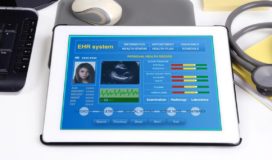
Electronic Health Records
What are Electronic Health Records (EHR)?
Electronic health record or EHR is the systematized collection of patient’s health records and information in a digital format. These records are kept in the system that makes the storage and transfer of information easy. For example, every patient has a patient chart and an EHR is a digital version of this. A typical medical EHR report might include information regarding patient demographics, medications, progress notes, health problems, vital signs, immunizations, past medical history, radiology reports and laboratory data etc.
The EHR system has been devised to store data accurately and capture the condition of the patient efficiently. They are the real-time patient-centered records that instantly & securely deliver the information to the authorized users. One of the major benefits of EHRs is that it enables the patient to get their medical history and prescriptions from their doctor from anywhere. This system has been built to go beyond the standard clinical data and provide the broader view of the patients’ medical condition.
EHR Features
- Providing accurate and up-to-date information about patients’ health
- Providing quick access to patient’s medical report for a coordinated health care
- Secure sharing of medical information between patients and other clinicians
- Reduction of costs through decreased paperwork
- Enhancing security and privacy of patient data
- Helping providers improve productivity
What are the Benefits of Electronic Health Records?
Electronic Health Records offer numerous advantages for healthcare providers, patients, and healthcare systems alike. Here are some key benefits:
- Improved Accessibility: EHRs provide easy access to patient information anytime and anywhere. Healthcare providers can securely access patient records remotely, which is particularly beneficial in emergency situations or when treating patients across different healthcare facilities.
- Enhanced Coordination of Care: EHRs facilitate better coordination of care among healthcare providers, specialists, and other stakeholders involved in a patient’s treatment. All pertinent information, such as medical history, test results, and treatment plans, can be readily shared, ensuring that everyone involved in the patient’s care is on the same page.
- Increased Efficiency: By digitizing health records, EHRs streamline administrative tasks such as appointment scheduling, billing, and prescription management. This improves workflow efficiency, allowing healthcare providers to devote more time to patient care.
- Reduced Errors: EHRs minimize the risk of errors associated with illegible handwriting or misplaced paper records. Electronic documentation is standardized and can include built-in alerts and reminders for important tasks such as medication reconciliation and allergy notifications, reducing the likelihood of medical errors.
- Data Analytics and Population Health Management: EHRs enable the collection and analysis of large amounts of patient data, which can be leveraged for population health management initiatives. Healthcare providers can identify trends, monitor disease outbreaks, and implement targeted interventions to improve public health outcomes.
- Patient Empowerment: EHRs empower patients to take a more active role in their healthcare journey. Patients can access their own health records online, review test results, and communicate with their healthcare providers securely through patient portals. This promotes transparency and fosters a collaborative relationship between patients and providers.
- Cost Savings: While the initial investment in implementing EHR systems may be significant, studies have shown that over time, the use of EHRs can lead to cost savings through reduced paperwork, fewer redundant tests, and improved efficiency.
Electronic Health Records offer a multitude of benefits that contribute to better patient care, improved healthcare outcomes, and increased efficiency in healthcare delivery.
Major Information an EHR Contains
- Laboratory Results: EHR contains the reports of all the lab tests of the patient. With EHR the patient and the medical clinic need not to keep these papers separately in the file.
- Images from Radiology: EHR system holds the images from radiology like x-rays so whenever the provider needs such images, they can easily get it from the EHR system.
- Allergy Information and Warnings: Different persons have different health issues and all this information is stored in EHR. The EHR system shows all the types of allergies issues and other sorts of things a person is prone to.
- Dates of Immunization: The immunization dates are stored in the system and the remainder is given to doctors as well as to the patients when the actual dates are near.
- Medications relevant to the patient: EHR includes the medications which have been prescribed by the doctor to the patient.
- Patient’s Medical History: This system not only contains the data about the current condition but also about the previous medical history of the patient.
- Progress Notes: Progress notes shows how the condition of the patient is improved with the prescribed medication and treatment.
- Demographics of the patient: EHR contains all the information about height, weight, blood group etc of the patient.
EHR has helped in transforming the ways the medical treatment were used to be given earlier. These are built to share the information with the other health care providers and organizations like labs, specialists, pharmacies, emergency facilities and workplace clinics. Therefore, it can be called as the major hub where all the information regarding the patient health is stored.
Health IT



